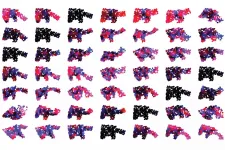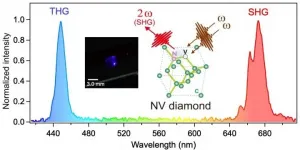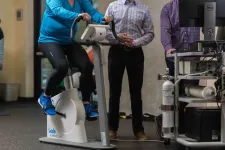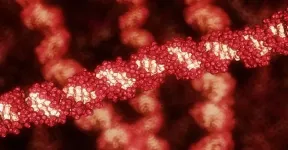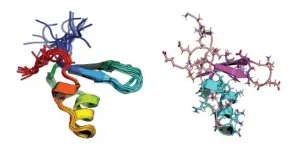(Press-News.org) There are some tasks that traditional robots -- the rigid and metallic kind -- simply aren't cut out for. Soft-bodied robots, on the other hand, may be able to interact with people more safely or slip into tight spaces with ease. But for robots to reliably complete their programmed duties, they need to know the whereabouts of all their body parts. That's a tall task for a soft robot that can deform in a virtually infinite number of ways.
MIT researchers have developed an algorithm to help engineers design soft robots that collect more useful information about their surroundings. The deep-learning algorithm suggests an optimized placement of sensors within the robot's body, allowing it to better interact with its environment and complete assigned tasks. The advance is a step toward the automation of robot design. "The system not only learns a given task, but also how to best design the robot to solve that task," says Alexander Amini. "Sensor placement is a very difficult problem to solve. So, having this solution is extremely exciting."
The research will be presented during April's IEEE International Conference on Soft Robotics and will be published in the journal IEEE Robotics and Automation Letters. Co-lead authors are Amini and Andrew Spielberg, both PhD students in MIT Computer Science and Artificial Intelligence Laboratory (CSAIL). Other co-authors include MIT PhD student Lillian Chin, and professors Wojciech Matusik and Daniela Rus.
Creating soft robots that complete real-world tasks has been a long-running challenge in robotics. Their rigid counterparts have a built-in advantage: a limited range of motion. Rigid robots' finite array of joints and limbs usually makes for manageable calculations by the algorithms that control mapping and motion planning. Soft robots are not so tractable.
Soft-bodied robots are flexible and pliant -- they generally feel more like a bouncy ball than a bowling ball. "The main problem with soft robots is that they are infinitely dimensional," says Spielberg. "Any point on a soft-bodied robot can, in theory, deform in any way possible." That makes it tough to design a soft robot that can map the location of its body parts. Past efforts have used an external camera to chart the robot's position and feed that information back into the robot's control program. But the researchers wanted to create a soft robot untethered from external aid.
"You can't put an infinite number of sensors on the robot itself," says Spielberg. "So, the question is: How many sensors do you have, and where do you put those sensors in order to get the most bang for your buck?" The team turned to deep learning for an answer.
The researchers developed a novel neural network architecture that both optimizes sensor placement and learns to efficiently complete tasks. First, the researchers divided the robot's body into regions called "particles." Each particle's rate of strain was provided as an input to the neural network. Through a process of trial and error, the network "learns" the most efficient sequence of movements to complete tasks, like gripping objects of different sizes. At the same time, the network keeps track of which particles are used most often, and it culls the lesser-used particles from the set of inputs for the networks' subsequent trials.
By optimizing the most important particles, the network also suggests where sensors should be placed on the robot to ensure efficient performance. For example, in a simulated robot with a grasping hand, the algorithm might suggest that sensors be concentrated in and around the fingers, where precisely controlled interactions with the environment are vital to the robot's ability to manipulate objects. While that may seem obvious, it turns out the algorithm vastly outperformed humans' intuition on where to site the sensors.
The researchers pitted their algorithm against a series of expert predictions. For three different soft robot layouts, the team asked roboticists to manually select where sensors should be placed to enable the efficient completion of tasks like grasping various objects. Then they ran simulations comparing the human-sensorized robots to the algorithm-sensorized robots. And the results weren't close. "Our model vastly outperformed humans for each task, even though I looked at some of the robot bodies and felt very confident on where the sensors should go," says Amini. "It turns out there are a lot more subtleties in this problem than we initially expected."
Spielberg says their work could help to automate the process of robot design. In addition to developing algorithms to control a robot's movements, "we also need to think about how we're going to sensorize these robots, and how that will interplay with other components of that system," he says. And better sensor placement could have industrial applications, especially where robots are used for fine tasks like gripping. "That's something where you need a very robust, well-optimized sense of touch," says Spielberg. "So, there's potential for immediate impact."
"Automating the design of sensorized soft robots is an important step toward rapidly creating intelligent tools that help people with physical tasks," says Rus. "The sensors are an important aspect of the process, as they enable the soft robot to "see" and understand the world and its relationship with the world."
INFORMATION:
This research was funded, in part, by the National Science Foundation and the Fannie and John Hertz Foundation.
Written by Daniel Ackerman, MIT News Office
Paper: "Co-Learning of Task and Sensor Placement for Soft Robotics"
https://ieeexplore.ieee.org/stamp/stamp.jsp?tp=&arnumber=9345345
Tsukuba, Japan - Researchers from the Department of Applied Physics at the University of Tsukuba demonstrated second-order nonlinear optical effects in diamonds by taking advantage of internal color center defects that break inversion symmetry of diamond crystal. This research may lead to faster internet communications, all-optical computers, and even open a route to next generation quantum sensing technologies.
Current fiber optical technology uses light pulses to transfer broad-bandwidth data that let you check your email, watch videos, and everything else on the Internet. The main drawback is that light pulses hardly interact with each other, so the information must be converted into electrical signals to allow your computer ...
In a recent study testing the effects of exercise on overall metabolism, researchers at Oregon State University found that even a single session of moderate aerobic exercise makes a difference in the cells of otherwise sedentary people.
Mitochondria are the part of the cell responsible for the biological process of respiration, which turns fuels such as sugars and fats into energy, so the researchers focused only on mitochondria function.
"What we found is that, regardless of what fuel the mitochondria were using, there were mild increases in the ability to burn off the fuels," said Matt Robinson, lead author on the study and an assistant professor ...
Melbourne researchers have revealed how melanoma cells are flooded with DNA changes as this skin cancer progresses from early, treatable stages through to fatal end-stage disease.
Using genomics, the team tracked DNA changes occurring in melanoma samples donated by patients as their disease progressed, right through to the time the patient died. This revealed dramatic and chaotic genetic changes that accumulated in the melanoma cells as the cancers progressed, providing clues to potential new approaches to treating this disease.
The research, published in Nature Communications, was led by Professor Mark Shackleton, Professor Director of Oncology at Alfred Health and Monash University; Professor ...
Clinically, multiple lines of evidence show that chronic pain and depressive symptoms are frequently encountered. Patients suffered from both pain and depression are likely to become insensitive to drug treatment, indicating a refractory disease. The neural mechanism under this comorbidity remains unclear.
In a study published in Nature Neuroscience, the research team led by Prof. ZHANG Zhi and Dr. LI Juan from the University of Science and Technology of China (USTC) of the Chinese Academy of Sciences (CAS), reported the discrete thalamocortical circuits underlying the pain symptom caused by tissue injury and depression-like states.
Being the gateway towards cerebral cortex and considered as the major source of 'nociceptive ...
The research team led by Prof. ZHANG Jie from the University of Science and Technology of China (USTC) of the Chinese Academy of Sciences made progress on real-time determination of earthquake focal mechanism through deep learning. The work was published in Nature Communications.
Since there are connections between characteristics of the rupture surface of the source fault and seismic wave radiated by the source, it's vital to monitor the earthquake by immediate determination of the source focal mechanism which inferred from multiple ground seismic records.
However, it's hard to calculate the mechanism from the simple ...
A combination of an array of atomic-level techniques has allowed researchers to show how changes in an environment-sensing protein enable bacteria to survive in different habitats, from the human gut to deep-sea hydrothermal vents.
"The study gives us unprecedented atomic-level insight into how bacteria adapt to changing conditions," says Stefan Arold, professor of bioscience at KAUST. "To obtain these insights, we pushed the limits of three different methods of investigation and combined their results into a unified picture."
The histone-like nucleoid-structuring (H-NS) protein allows bacteria to sense changes in their environment, such as changes in temperature and salinity. Previously, the team had shown how the intestinal pathogen Salmonella typhimurium ...
People are not very nice to machines. The disdain goes beyond the slot machine that emptied your wallet, a dispenser that failed to deliver a Coke or a navigation system that took you on an unwanted detour.
Yet USC researchers report that people affected by COVID-19 are showing more goodwill -- to humans and to human-like autonomous machines.
"The new discovery here is that when people are distracted by something distressing, they treat machines socially like they would treat other people. We found greater faith in technology due to the pandemic and a closing of the gap between humans and machines," said Jonathan Gratch, senior author of the study and director for virtual humans research at the USC Institute for Creative Technologies.
The findings, which appeared recently ...
Cancer immunotherapy may get a boost from an unexpected direction: bacteria residing within tumor cells. In a new study published in Nature, researchers at the Weizmann Institute of Science and their collaborators have discovered that the immune system "sees" these bacteria and shown they can be harnessed to provoke an immune reaction against the tumor. The study may also help clarify the connection between immunotherapy and the gut microbiome, explaining the findings of previous research that the microbiome affects the success of immunotherapy.
Immunotherapy treatments of the past decade or so have dramatically improved recovery rates from certain ...
National work-family policies that give lower-income families more time together while allowing them paid time off are more effective for children's psychological health than cash transfers, according to a study of developed nations led by Baylor University.
In a study of about 200,000 children in 20 developed nations, the United States ranked lowest in overall policies aimed at helping parents support children.
The study, published in the journal Social Forces, supports the view of critics who say that the United States government does not do enough to mandate ...
Repeatedly getting angry, hitting, shaking or yelling at children is linked with smaller brain structures in adolescence, according to a new study published in Development and Psychology. It was conducted by Sabrina Suffren, PhD, at Université de Montréal and the CHU Sainte?Justine Research Centre in partnership with researchers from Stanford University.
The harsh parenting practices covered by the study are common and even considered socially acceptable by most people in Canada and around the world.
"The implications go beyond changes in the brain. I think what's ...
